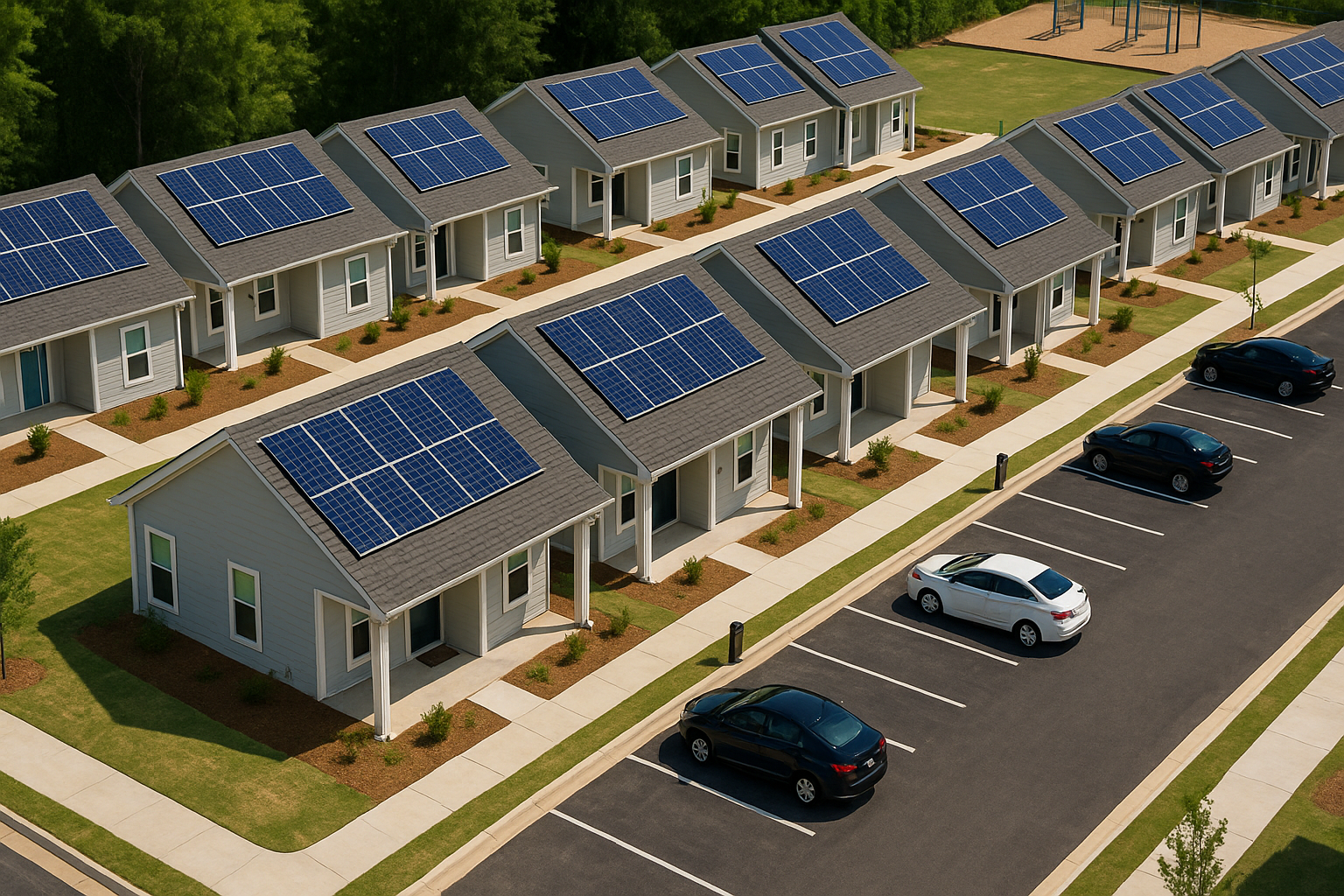Build‑to‑Rent Communities Reshaping U.S. Housing
Aerial view build-to-rent cottages with EV chargers.
Only a handful of years ago, “build‑to‑rent” sounded like insider slang whispered in private‑equity hallways. Today it runs across Bloomberg crawlers, TikTok house tours, and municipal zoning dockets. Active construction pipelines have soared beyond 110 000 homes—roughly the number of new hotel keys the United States added in the past decade. Google search trends confirm the buzz: “build‑to‑rent” now outranks “tiny house,” “barn‑dominium,” and “prefab cabin” combined, signaling the concept has jumped from industry white papers to mainstream curiosity.
Three macro forces ignited the surge. First, mortgage rates hovering above six percent froze millions of homeowners in ultra‑low‑rate loans, suffocating resale supply. Second, Millennials reached the minivan‑and‑back‑yard life stage just as starter‑home inventory evaporated. Third, pension funds hunting inflation‑indexed yield re‑allocated billions into institutional single‑family rental portfolios. Layer on cloud analytics that reprice renewals with airline precision, and you get the decade’s most talked‑about housing segment.
Fresh metrics drive the point home. Freddie Mac pegs build‑to‑rent’s share of new single‑family starts at nearly eight percent—quadruple 2016 levels. Across thirty metros, average BTR rent per square foot sits about twenty‑three percent above 1990s vintage rentals, yet annual turnover is eight percent lower. Vacancy hovers near four percent, even off‑season, while tenant Net‑Promoter Scores regularly exceed sixty—territory usually reserved for boutique hotels.
Why does this alignment matter? Mortgage inertia, demographic pressure, institutional liquidity, and AI‑enabled data seldom align. Right now they do. The synergy is redrawing America’s roofline faster than any statewide zoning overhaul. Cities view BTR as a pressure valve; investors tout it as a bond proxy dressed in bricks; renters regard it as a homeownership test‑drive—yard included—without the thirty‑year mortgage.
Humor break: Uncle Larry still says, “Buy a fixer‑upper.” Fine advice—until you tour a rental where lawn care, dog‑wash days, and EV charging arrive before noon.
Inside the Modern BTR Machine: Blueprint, Flywheel, and Daily Life
The Ownership & Operations Flywheel—Now in High Definition
Picture Costco purchasing power applied to an entire subdivision. One sponsor controls every roof, negotiating national contracts on everything from asphalt shingles to leak‑sensor batteries. IoT monitors ping maintenance crews before tenants notice issues, transforming potential two‑grand drywall repairs into ten‑minute gasket swaps. Each averted headache boosts resident satisfaction, curbs turnover, and anchors vacancy around four percent. Lower vacancy compresses cap rates, which fuels cheaper financing to bankroll the next community—completing a loop that spins faster with every stabilized site.
Over time, that loop strengthens brand equity. Residents view the operator like a lifestyle subscription: predictable service, no surprise repairs, and perks such as pop‑up farmers markets. Lenders appreciate the steady cash‑flow rhythm and now quote BTR loans alongside garden‑apartment deals. The flywheel graduates from experiment to asset class.
A Weekend Inside a BTR Neighborhood—Extended Cut
Saturday dawn: smart blinds rise automatically in a Nashville cottage, triggered by sunlight sensors. The resident’s phone buzzes—half‑price dog‑wash day. After a bark‑park romp through agility tunnels, she reserves a climate‑controlled Zoom pod, a backyard micro‑office wired for gigabit internet. Lunchtime farmers‑market stalls line the main boulevard, selling hydroponic greens grown in shipping‑container farms behind the leasing office. A visiting food‑truck convoy rolls in for dinner, sponsored by a local brewery that offers residents half‑pint punch cards. As dusk sets, a community movie night streams on an inflatable screen powered by rooftop solar, while a maintenance tech quietly tightens an outdoor spigot flagged by the meter’s AI.
Every touchpoint—from pet wash fees and Zoom‑pod rentals to vendor stall licenses and solar‑powered movie nights—adds hidden revenue streams that fatten the bottom line without raising base rent.
Performance Wins with Storytelling over Spreadsheets
Preventive maintenance acts like concierge service, slicing insurance claims and boosting online reviews. Pet‑inclusive policies, once a landlord’s nightmare, now add revenue through pet rent while claw‑proof flooring curbs damage. Community‑wide mesh Wi‑Fi, purchased wholesale, yields small margins that fund landscaping. The sum: sub‑four‑percent vacancy, delinquency below two percent, and digital reviews reading like resort testimonials—fuel that attracts the next wave of tenants at minimal marketing cost.
“Residents playing pickleball at build-to-rent community.”
Six Mega‑Forces Steering the Boom Toward 2027—A Deeper Dive
• Mortgage gridlock: Fifteen million owners cling to sub‑five‑percent loans, throttling resale listings and funneling would‑be buyers into rentals.
• Millennial migration: Population bulge shifts from downtown lofts to suburbs with playgrounds and dog‑wash stations.
• Boomer downsizing: Equity‑rich but maintenance‑averse, seniors opt for single‑story cottages without lawn equipment.
• Capital supercycle: Pensions and endowments name BTR the “next infrastructure,” allocating funds once earmarked for toll roads.
• Starter‑home drought: Even with a fifty‑three‑percent surge in starts, BTR plugs only a fraction of America’s entry‑level gap—runway remains long.
• Prop‑tech acceleration: AI chatbots schedule repairs, GPT models price renewals weekly, and water‑usage dashboards email conservation tips—each tweak adding basis points to NOI and exit value.
Stakeholder Playbooks—Expanded Narratives and Action Steps
Renters swap a modest rent premium—generally eight to fifteen percent—for brand‑new appliances, fenced yards, and prompt maintenance fixes. Savvy tenants leverage renewal‑cap riders pegged to CPI plus one percent and ask for EV‑charger installs in exchange for extended lease terms.
Investors capture bond‑like yields between four and six percent with stock‑market‑level liquidity. To offset cap‑rate compression in headline metros, capital rotates into secondary Sunbelt cities—Greenville, Huntsville, Chattanooga—where spreads sit roughly sixty basis points wider, yet absorption remains brisk.
Developers wrestle land cost escalation but fight back with lumber futures, panelized framing, and C‑PACE financing that can shave measurable points off weighted cost of capital. Many now pursue design‑build contracts, aligning contractor incentives with sponsor returns.
Cities juggle NIMBY sentiment and tax‑base hunger. BTR offers a sweet spot: single‑family silhouettes without deed transfers, historically correlated with fewer school‑age children per roof. Municipalities fast‑track permits when developers pledge twenty‑percent workforce allotments or donate easements for bike trails.
Lenders once wary of novelty now lean on three decades of single‑family rental data. Securitization desks pool stabilized BTR properties the same way they bundle Class‑A apartments, adding liquidity and lowering refinance risk.
Design and ESG—From Carbon‑Lite to Net‑Zero Ready
Advanced framing lasers precut studs, slashing wood waste twenty‑five percent and trimming build schedules by ten working days. Heat‑pump HVAC coupled with hybrid water heaters slices energy profiles roughly thirty percent, making ESG‑linked loans easier to secure. Roof trusses arrive solar‑ready; conduits and meter gangs are pre‑installed, cutting future solar labor costs by eighty‑plus percent.
Landscaping focuses on resiliency: xeriscape palettes shrug off watering bans; permeable pavers shrink detention pond footprints and earn storm‑water fee credits. Communities in drought‑prone markets pilot “blue‑bucket rebates,” rewarding residents who swap grass for gravel—then selling saved water to municipal utilities.
Amenities convert into income streams. Pergola‑covered grill decks rent for family reunions; refrigerated parcel lockers charge delivery services per package; e‑bike fleets sync with wellness apps, logging mileage the sponsor sells back to corporate health programs. These micro‑revenues collectively add forty to sixty basis points to yield without touching rent.
ESG badges unlock capital. ENERGY STAR homes tap the 45L credit; NGBS Bronze scoring wins utility rebates and trims debt pricing by up to ten basis points. Net‑Zero Ready certifications open European pension funds previously barred from U.S. housing deals, often shaving a quarter‑point from loan spreads.
Financing Toolbox—Layered Like Lasagna
Take a theoretical fifty‑million‑dollar build on twenty Charlotte acres. Two‑thirds sits on senior construction debt, floating near SOFR plus three points, capped with a two‑percent collar. Five million in green C‑PACE funding anchors energy upgrades at five percent fixed for a quarter‑century and counts partially as equity in LTC calculations. Sponsor equity—just above eight million—earns a thirty‑percent promote once returns exceed twelve percent. Limited partners cover the remaining slice, draw an eight‑percent preferred coupon, and clip seventy percent of the upside.
Exit scenarios range from merchant sales within twenty‑four months—generating one‑point‑eight equity multiples—to refinance‑and‑hold plays yielding double‑digit cash‑on‑cash for a decade. Ambitious sponsors stitch multiple sites into a roll‑up IPO, chasing mid‑teens IRR and tripled equity but accepting market‑timing risk.
Taxes sweeten the pie: claim five‑grand 45L credits per ENERGY STAR home before they halve, layer §179D deductions if local emergency crews lease units during relocation, and front‑load bonus depreciation while eighty‑percent write‑offs remain legal.
“Build-to-rent investor analyzes rent forecast dashboard.”
Global Lessons—Four Continents, One Guiding Thread
Britain’s horizontal BTR communities in Greater Manchester lease out even under CPI‑light caps. Australian land‑lease villages attract super‑fund capital by waiving GST on home purchases. Canada’s CMHC‑backed mortgages cut borrowing costs nearly a point under bank prime, sparking cottage‑style BTR in frosty Calgary. Germany’s ninety‑nine‑year ground leases shave land basis by twenty percent. Emerging Mexican rent‑to‑own fintech pilots let tenants earn equity credits with on‑time payments, blending BTR operational efficiency with ownership dreams.
Shared lesson: pair modest fiscal carrots with predictable regulation, and capital floods in; layer punitive rent caps or complex levies, and pipelines stall.
Atlanta Frontlines—Boots in the Red Clay
Metro Atlanta’s south arc acts as a real‑time lab. Clayton County pre‑leases units at a three‑inquiry‑to‑one‑unit ratio. Henry County’s projects anchor near a 2026 hospital campus, courting traveling nurses on thirteen‑week contracts. Fayette’s solar‑equipped cottages woo Disney‑adjacent film crews tired of Airbnb roulette. South Fulton interlocks everything with airport‑driven industrial growth.
Oakley Station converted a dormant pecan orchard into 140 smart cottages. Forty‑one days post‑CO, units averaged $1 975 monthly—twenty percent above underwrite. A rentable podcast booth, wired for fiber and furnished under five thousand dollars, books forty hours monthly at twenty dollars per hour, wiping half the annual tax bill.
Chattahoochee Bend strings solar carports across its eighty‑plus homes. Common‑area energy costs drop eighteen percent, letting management funnel savings into pocket‑park maintenance, which in turn elevates renewal retention.
Emerging corridors to track: McDonough’s logistics marathon of warehouses, Airport South’s film‑studio swing shifts, and the I‑85 innovation spine attracting data‑center engineers who expense community coworking pods instead of converting guest bedrooms.
Risk Toolkit—From Financing to Fire Weather
Cap‑rate creep looms, yet historical spreads to garden apartments remain inside fifteen basis points over a decade. Sponsors fortify by holding beefier interest‑only reserves and layering swap caps. Material inflation gets contained through guaranteed‑max contracts and forward lumber buys. Lease‑up lag shrinks when TikTok virtual tours secure deposits months ahead of ribbon‑cutting. Zoning strife eases when developers proffer community gardens, daycare pods, or trail easements. Climate risk lessens under elevated slabs, metal roofs, and fire‑resistant fiber‑cement siding—features insurers increasingly require.
Myths and FAQs—Long‑Form Clarity
Myth: BTR cannibalizes starter homes. Truth: many projects activate parcels too dense for detached sale yet too sparse for apartments, effectively delivering “missing middle” stock.
Myth: Personalization is banned. Reality: resident apps let tenants request accent walls, vegetable beds, or pet doors—usually for a refundable deposit.
Myth: Hedge funds dominate. Fact: regional builders spearhead more than sixty percent of communities under 300 homes, often partnering with local trade schools.
Burning questions: leases stretch twelve‑to‑eighteen months; HOA‑style fees are bundled; remote work flies, but retail foot traffic needs landlord sign‑off.
Five Future Signals Savvy Readers Should Track
AI leasing bots will nudge rents weekly, mirroring airline seats. Zero‑water xeriscapes may become mandatory in drought‑stressed metros, swapping lawns for pollinator gardens. Century‑long ground leases could slash land costs in fee‑simple cities. Refrigerated parcel lockers will monetize grocery deliveries and return logistics. Mixed‑income 60/40 deals—forty percent workforce, sixty percent market—will breeze through zoning boards, creating a hybrid asset class.
Closing Thoughts—Backyards Meet the Subscription Economy
The white‑picket‑fence fantasy is evolving into a managed subscription. Build‑to‑rent wraps lawn care, pet perks, community Wi‑Fi, and smart‑home tech into a single predictable fee—no mortgage anxiety attached. Decode today’s financial, design, and regulatory levers, and you won’t just ride the boom; you’ll help script the next chapter of American housing.


